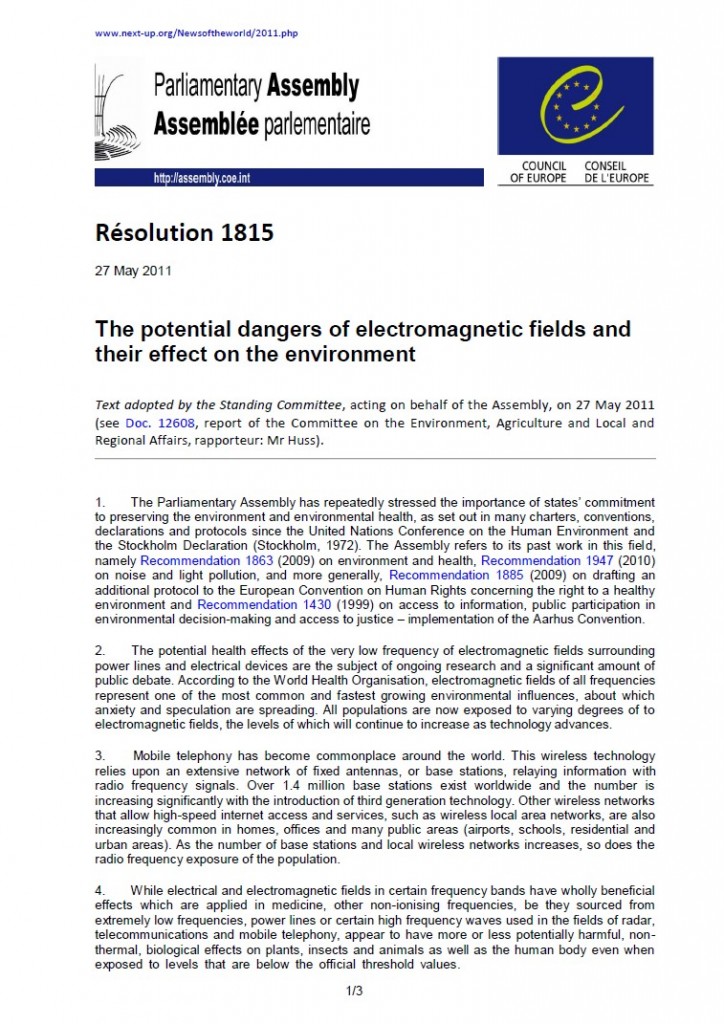Portada del sitio > Fauna > Mobile Phones & Vanishing Birds
Mobile Phones & Vanishing Birds
Martes 29 de mayo de 2007 · 1433 lecturas
Mobile Phones & Vanishing Birds
*******************************
*******************************
Birds near mobile phone base stations do not breed well Dr.
Mae-Wan Ho
A fully referenced version of this article is posted on ISIS
members’ website.
Where did all the sparrows go?
******************************
The sparrows have disappeared completely from the cities at
least four years ago in Britain, as mobile phones grew in
popularity. Third generation (3G) mobile phones were
introduced in 2003, and there were over 65 million users in
the UK by the end of 2005, more phones than people [1]. Did
mobile phone transmitters cause the sparrows to disappear
[2]?
Scientists at the Research Institute for Nature and Forests
in Brussels, Belgium, have produced the first evidence that
mobile phone base stations are affecting the reproductive
behaviour of wild sparrows [3]. This finding comes as mobile
phones are held suspect in the massive collapse of bee
colonies all over the United States and Europe [4] ( Mobile
Phones and Vanishing Bees , SiS 34).
Joris Everaert and Dirk Bauwens wanted to know if the low
intensity microwave radiation from mobile phone base
stations has any effect on the number of house sparrows
during the breeding season. They identified 150 locations
distributed over six residential districts in Gent, Sint and
Niklaas in the province of East Flanders, where they counted
the number of male house sparrows and measured the strength
of electromagnetic radiation from base stations.
The study areas were similar, with abundant hedges, bushes,
and other vegetation between the houses, and one or more GSM
(Global System for Mobile Communications) base stations
nearby. All locations were along small roads within the
residential areas and at variable distances from the nearest
GSM (mean 352 m, range 91-903 m, about 90 percent at 100-600
m). On days when the weather was favourable, so male
sparrows would be out singing, the researchers went to each
location between 7 and 11 am, and using binoculars, counted
the number of male sparrows within a radius of about 30 m
for a period of five minutes.
Simultaneously, they measured the maximum value of the
electric field strength (in V/m) from the GSM 900 MHz and
GSM 1800 MHz base station antennas during 2 minutes for each
frequency band, using a portable calibrated high-frequency
spectrum analyser.
Everaert and Bauwens found that the number of house sparrow
males varied between zero and four at the different
locations. The measured electric field strengths were seldom
higher than 1V/m, and most often well below that value.
Nevertheless, the spatial variation in the number of house
sparrow males was negatively and highly significantly
correlated to the strength of electric fields from both the
900 and 1800 MHz frequency bands and from the sum of these
bands. This negative correlation was very similar within
each of the six districts, despite differences in both the
number of birds and radiation levels.
Fewer house sparrow males were seen at locations within
relatively high electric field strengths of GSM base
stations. For example, the mean number of male sparrows
varied from 1.9 at the combined field intensity of 0.13 V/m
to 0.8 at a combined field intensity of 0.247 V/m.
The results, though preliminary, do support the hypothesis
that long-term exposure to higher levels of radiation
negatively affects the abundance or behaviour of house
sparrows in the wild. Fewer males singing would mean less
breeding success.
White storks breeding success plummets near mobile phone
transmitters
*********************************************************
Sparrows are not the only wild birds affected. Phone masts
were found to actually reduce the breeding success of white
storks in Spain.
Alfonso Balmori, a conservation biologist in Valladolid,
Spain, reported a significantly lower number of white stork
( Ciconia ciconia ) fledglings in nests close to mobile
phone transmitters compared to nests further away [5].
To monitor the breeding success of the white stork
population, 60 nests were selected and visited from May to
June of 2003. The selected nests had similar
characteristics. They were located on the roof of churches
and buildings inside urban centres in Valladolid. As the
cell phone transmitters are everywhere, very few places had
zero background intensity. So nests were chosen that were
exposed at very high or very low levels of EMR, depending on
the distance from the nests to the antennas.
Leer el resto del artículo AQUÍ







